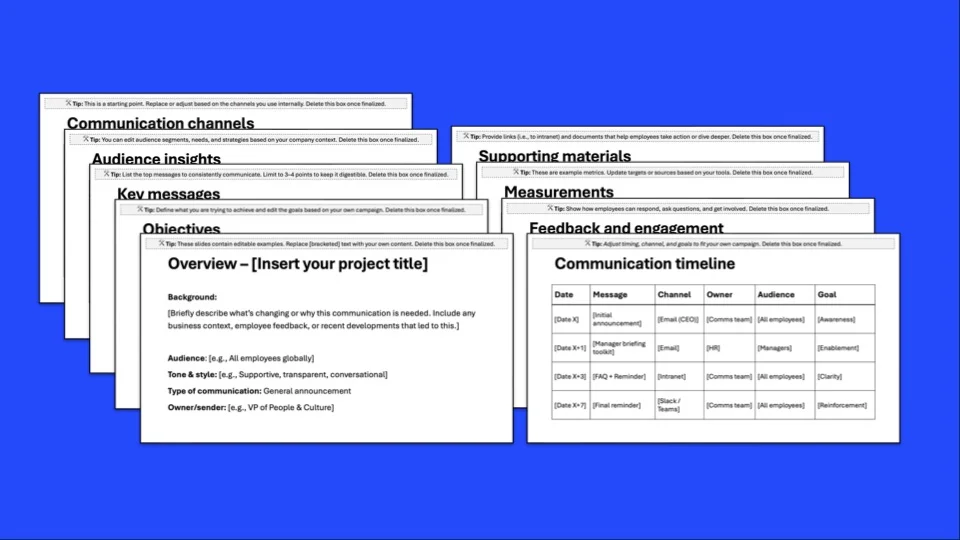Leadership styles in internal communications play a crucial role in shaping trust, engagement, and clarity within teams. The way leaders communicate influences how well employees align with company goals, how engaged they feel, and how effectively they collaborate. Studies indicate that leadership behavior directly impacts employee communication effectiveness and workplace collaboration.
For instance, transformational leaders who prioritize storytelling and vision-based messaging often see higher employee engagement, while authoritative leaders may streamline decision-making but risk limiting open dialogue.
The impact of leadership styles on internal communications is particularly evident in hybrid and remote work environments. A 2024 study found that managers who lacked formal training in hybrid leadership struggled to maintain clarity, leading to a decline in workplace engagement. Conversely, adaptive leaders who tailor communication strategies to evolving team needs have been more successful in keeping employees aligned.
Understanding these dynamics helps internal communication teams craft leadership messaging that resonates, builds trust, and drives engagement. This guide explores how various leadership styles influence internal communication and provides actionable strategies to enhance message clarity and effectiveness.
The impact of leadership styles in internal communications
| Leadership Style | Communication strengths | Potential pitfalls |
|---|---|---|
| Authoritative | Clear directives, fast decisions | Limits feedback, discourages creativity |
| Democratic | Encourages collaboration, builds trust | Slower decision-making |
| Laissez-Faire | Empowers employees, fosters autonomy | Can cause confusion due to lack of guidance |
| Transformational | Inspires innovation, strong storytelling | Risk of vision without execution clarity |
| Servant | Prioritizes employee needs, fosters loyalty | Can lead to unclear expectations |
| Adaptive | Adjusts to changes, flexible communication | Inconsistency may cause confusion |
1. Authoritative leadership (top-down communication)
- Provides clear direction and structure.
- Limits open discussion, reducing innovation and engagement.
💡Tip: Create structured feedback loops to allow for two-way communication.
2. Democratic leadership (two-way engagement)
- Encourages participation and team involvement.
- Can slow decision-making if too many voices are included.
💡Tip: Use surveys or quick polls to collect input efficiently.
3. Laissez-faire leadership (hands-off communication)
- Works well with self-driven teams.
- Can create ambiguity when expectations aren’t clear.
💡Tip: Set periodic check-ins to ensure alignment while maintaining autonomy.
4. Transformational leadership (vision-driven messaging)
- Uses storytelling to inspire and align teams.
- Can overwhelm employees with too many initiatives.
💡Tip: Tie visionary messaging to concrete, short-term goals.
5. Servant leadership (empathy-focused communication)
- Strengthens trust and employee morale.
- Can lead to decision-making ambiguity.
💡Tip: Communicate clear expectations while prioritizing employee needs.
6. Adaptive leadership (context-driven communication)
- Adjusts messaging based on team and situation.
- Can cause confusion if shifts are not well explained.
💡Tip: Ensure consistency by keeping core values and messaging clear.
Recent trends and research in leadership communication (2023-2025)

Hybrid work challenges
Hybrid and remote work have reshaped leadership communication, yet 70% of managers report receiving no formal training on leading distributed teams. Without structured guidance, leaders struggle to convey expectations clearly, leading to engagement declines and misalignment across teams. Organizations now focus on upskilling leaders to improve virtual communication, using strategies such as structured town halls and AI-powered engagement tools.
AI in internal communication
Artificial intelligence is revolutionizing workplace communication, with 80% of internal communication professionals open to AI-assisted messaging. AI-driven tools now help leaders craft clearer, more personalized messages while automating routine updates. However, AI adoption also raises concerns about maintaining authenticity and trust.
To learn how AI can enhance leadership messaging, check out AI-powered teams: The ultimate edge in collaboration for 2025.↗
Leadership trust decline
Employee trust in leadership is eroding, with 67% of internal communication professionals identifying transparency as a top priority. Inconsistent messaging and a lack of clear direction contribute to skepticism. To counteract this, leaders are adopting more open communication strategies, such as live Q&A sessions, video updates, and interactive employee feedback loops. The key is balancing transparency with strategic clarity, ensuring employees feel informed while avoiding communication overload.
How internal communications teams can support leaders
Train leaders on messaging
Providing coaching and structured frameworks can help leaders refine their communication style, ensuring clarity and engagement. Leadership workshops, coaching sessions, and real-time feedback mechanisms allow leaders to improve their ability to convey key messages effectively. Encouraging leaders to develop a strong storytelling approach can make their messages more relatable and impactful.
Ensure multi-channel consistency
Leaders should leverage a combination of communication channels—including email, intranet, live video updates, and team collaboration platforms—to reach employees effectively. Each platform serves a different purpose; for instance, live video updates create a sense of transparency and personal connection, while structured intranet articles provide reference points for ongoing initiatives. Aligning communication efforts across multiple channels ensures that messaging remains clear and accessible to all employees.
Leverage employee feedback
Two-way communication is critical for internal communications success. Leaders can use employee surveys, pulse checks, and anonymous feedback tools to gauge the effectiveness of their communication strategies. By actively listening and adjusting messaging based on employee sentiment, organizations foster a culture of trust and engagement. For example, AI-driven sentiment analysis can help leadership teams analyze the tone and engagement levels of internal communications in real-time.
Promote inclusive messaging
Adapting communication styles to reflect the diversity of employees ensures that all team members feel heard and valued. Leaders should use plain language, avoid industry jargon, and ensure accessibility by offering translations or alternative content formats (such as audio versions or visual summaries). Incorporating employee voices through testimonials or success stories enhances authenticity and fosters an inclusive workplace culture.
Final thoughts
Effective leadership communication is not one-size-fits-all. By understanding how different management styles impact internal communication, leaders and communication teams can refine their strategies to foster clarity, trust, and engagement.
No matter the leadership style, every leader ultimately strives for team alignment. Discover the best internal communication platforms to keep your teams connected and engaged.↗






